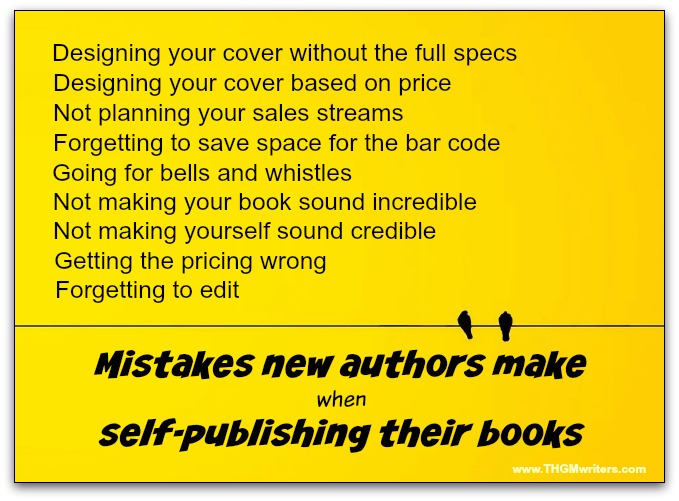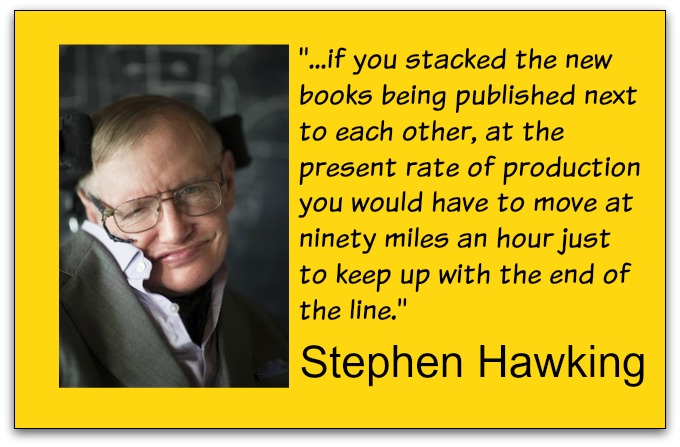Writing and publishing are two different worlds. But if a writer self-publishes, one needs to know a few things about publishing.
There’s nothing quite like the high of finally completing you manuscript. Yes!
But a manuscript is not a book. You still have to get it published.
And you have many options for publishing.
You can pitch literary agents and publishers. That’s the traditional way; you get the most help and make the least money.
You can go through an online book publisher. That is sometimes a good start.
You can go for eBook only. There are pros and cons to eBooks. It can also be a good start, but plan to get actual printed copies made.
Or you can self-publish, which means you print your own books. You get the least help, but you make the most money if you have a way to sell your books.
Self-publishing isn’t that hard, but there are a few mistakes to avoid.
Self publishing mistake #1: Designing your cover without the full specs
I put this as number one because I’ve seen it happen enough times. By specs, I mean the exact size of the cover. Most people think they get this right, then realize that they haven’t.
Why?
Because they work with the front cover dimensions only. For instance, they might design the cover for a six-inch by nine-inch trim size. Then they assume the back cover is the same size (which it is).
Then they design the cover based on those two cover surfaces.
That’s the mistake. There are actually three cover surfaces:
- front
- back
- spine
The spine width will vary by two factors:
- the number of pages, including the copyright page and any other pages before and after your actual manuscript
- the weight of the paper
If you don’t get this right, even by a millimetre, will anybody notice? Well, they won’t notice that you missed by a millimetre. But they will notice that the cover doesn’t seem to quite look professional.
So how do you calculate the width of the spine? You don’t; you ask your printer.
In other words, first you choose your printer, then you design your cover.
Self publishing mistake #2: Designing your cover based on price
What is the single most important factor in the success of your book?
Your amazing writing skills?
The captivating story or incredibly useful information?
Stellar reviews?
All of these are important, but none are as important as the first impression readers get when they look at your book. Why, because there is zero percent chance of them becoming readers without a positive first impression.
Don’t skimp on cover design.
That does not mean you need to commission original artwork, although that might be worth doing, especially for fiction. It does mean you should hire a professional designer who will take the time to do it right. It’s not a “great deal” to pay $10 for a cover design, because the designer will have to cram hours of work into a quarter hour to make your project worth her time.
Each year, there are at least 2.2 million books published. In 2018, Stephen Hawking wrote:
“…if you stacked the new books being published next to each other, at the present rate of production you would have to move at ninety miles an hour just to keep up with the end of the line.”
That’s a lot of competition fighting to make the best first impression.
Pay what it takes for a professional cover. As Derek Murphy writes, you want to “Make it pop!”
Self publishing mistake #3: Not planning your sales streams
Before deciding how to publish, you should plan your sale streams. This will affect how you publish. If you plan to sell only online, you will absolutely want to publish eBook versions. There is a lot to consider when choosing platforms.
You will also want paper copies in online bookstores. If online is your only sales stream, you might want to go with an on-demand printer (sometimes called “vanity publishers”). That’s what I did so many years ago with Climb Your Stairway to Heaven: The 9 habits of maximum happiness
But I had other sales streams in mind, so I printed hard copies from a traditional printer. These copies are much, much more professional looking, so they can more easily be sold to people at seminars and workshops. Plus, they present much better to foreign markets. Indeed, I made most of my revenue from foreign rights sales.
Make no mistake – if you can sell directly to customers, the profits from printing the books yourself are 4-5 times as high as going through an online publisher.
If you choose to print yourself, you will have to also decide where to deliver the books. Do you want them all at your house, at a fulfillment house or some mix of the two? To make that decision, you will need to first figure out your sales streams.
So it pays to choose your sales streams before choosing how to publish.
Self publishing mistake #4: Forgetting to save space for the bar code
If you plan to sell your book in stores (online and offline), you will need a bar code (with the embedded ISBN). That means you need a space on your cover with to place it.
You don’t need a solid color backing, as the bar code is black on white. But you need a space that doesn’t have a substantive part of the cover image, the cover blurb or your author bio.
Of course, if you plan to sell books only face-to-face, no bar code is needed.
And if you hire a proper designer, they already know to leave that space.
Self publishing mistake #5: Going for bells and whistles
If you decide to use an online publisher, don’t let them upsell you all sorts of attractive but unessential services, such as social media promotion. Most of these “extras” are not worth the price and certainly are not needed. If you want social media promotion, do it right by building up your own audience and interacting with it.
You don’t need a bell.
Or a whistle.
Self publishing mistake #6: Not making your book sound incredible
If you’ve gotten your book in front of audiences and your cover has made a good enough first impression, people will turn over your book to look at the back cover. One question they will need answered is:
“What’s this book all about?”
No matter what type of book, that is the top question the reader will ask. I’ve already addressed this issue in two previous posts:
The cover blurb will tell people whether this attractive-looking book is likely to hold their interest.
Self publishing mistake #7: Not making yourself sound credible
Another question they will ask is:
“Who is this person who wants to tell me something?”
This is almost as important as what the book is about.
In the case of fiction, the reader will want to know that the interesting topic is written in an interesting manner. Nobody wants to get bored reading your book. They also prefer listening to people they relate to.
Make sure your bio leaves them with a sense of who you are as a person and that you are recognized as an amazing writer.
Self publishing mistake #8: Getting the pricing wrong
You probably want to make as much money as possible from your book, right?. That’s understandable.
But you won’t make any money if you price your book too high, especially as an unknown author.
Check out a dozen books on similar topics and of similar length. Compare prices, and set yours toward the bottom of the range. This just makes good business sense.
Have you given any thought to currency?
Americans expect to see an American price. British buyers expect to see a British price. Canadians sometimes see only a US price, but they much prefer to also see the Canadian price. Consider your markets before deciding what currencies to use on the back of your book.
Self publishing mistake #9: Forgetting to edit
Oh, by the way. While you were celebrating the completion of your manuscript, did you remember to get it edited?
No matter how amazing a writer you are or how allergic you might feel about anybody shifting a comma or a preposition – or please-say-it-ain’t-true rearranging a sentence – you need an editor.
You need an editor, if for no other reason, to see the manuscript through someone else’s eyes than your own.
If you are writing for anybody other than for yourself, you need an editor.
Just to be sure this is clearly understood here is the formula for deciding whether of not to get an editor:
- For a personal diary with a lock on it, no editor is required.
- For anything else, get an editor.
Even just a copy editor will find typos. They will also find things that sound great to you with a certain intonation, but will sound very awkward when read by somebody else. Consider “that good looking glass”. You might think “that good-looking glass” when you write it. But readers might read it like “that good looking-glass.” Without an editor, you would not realize the hyphen is needed.
And there are many more reasons to hire an editor.
So many self publishing mistakes…
These are just some of the more common mistakes people make when self-publishing. Feel free to add your own in the comments below.
It helps to know what mistakes are most common, so as to avoid making them ourselves. There are so many books being published each year; wouldn’t it be great if yours was one of those being published properly?
Use this guide to avoid the worst self-publishing mistakes.




David,
I will bookmark your post and go through al my mistakes, regarding the self-publishing process I did for my first book on (black) tea. I will talk about this topic on my new podcast, The Perfect Cuppa: Tea Sketches.
Best Premises,
Martin
Hi Dave,
Good to be here again to read yet another informative piece on self-publishing. You brought out well the common mistakes one often do before venturing into a self-publishing event. The mistakes are to be really fixed before move forward.
Great share Dave. I am so glad to note that this post is curated on the pages of GrowthHackers the IM platform.
Keep sharing.
Have a healthy sharing ahead amidst this present COVID- 19 pandemic crisis.
Best
~ Phil
Don’t put a Canadian price on the book if you are not shipping to Canadian stores from a Canadian distributor who is billing in Canadian dollars.
Actually, The distributor has no bearing on it. If you are selling to humans in Canada, whatever the sales channel, they’ll want to see the price in Canadian dollars.
Many of us have made many of these often. Great checklist!
First time author self publishing a series of nonfiction picture books. I AM SO GLAD I found this list. I’m using it as my initial checklist as I journey to print. Thanks again from all the newbies!! (who might hv been too nervous to post)